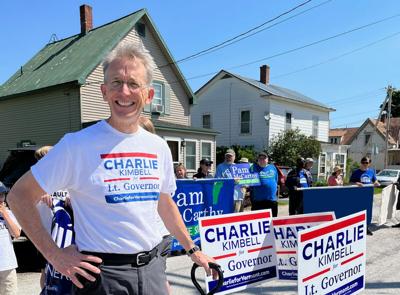ST. ALBANS — When Charlie Kimbell isn’t in the halls of the Vermont Statehouse, you might find him on his bike.
An avid mountain biker and gravel cyclist, Kimbell said he’s spent some of his campaign for lieutenant governor connecting with Vermonters out on the trails.
“There’s a whole mountain bike culture and community in the state that I can relate to,” he told the Messenger from Zoom.
On Aug. 9, Kimbell is vying to be the Democratic nominee for lieutenant governor. Now a state representative from Woodstock, he faces former Lt. Gov. David Zuckerman, Rep. Kitty Toll (D-Danville) and nonprofit leader Patricia Preson.
Kimbell spent his childhood and some of his adult years living and working in St. Albans. He learned to bike and ski at Hard’Ack Recreation Area as a kid and later served on its board of directors.
Kimbell also served on the St. Albans Free Library’s board of trustees and was chair of “Project: Bright Future,” committee that brought businesses and community members together in the 1990s to revitalize the greater St. Albans area.
“I ran for mayor and lost soundly to Peter DeLauriers, but it was a great lesson in politics,” Kimbell said.
Serving as lieutenant governor after three terms in the Vermont House would be the next logical step in continuing the work he’s become so passionate about, he said.
While in the Statehouse, Kimbell’s been a member of the House Commerce and Economic Development Committee as well as the tri-partisan rural development caucus, groups that he said have been doing work on today’s hot-button issues for years.
“For six years I have been focused on workforce development issues and have been meeting with the various stakeholders,” Kimbell said.
Under his leadership, the office of lieutenant governor would be used to bridge the gaps between the various agencies, commissions and programs dedicated to workforce development.
“There are so many people, and yet there's not that much in terms of an overall strategic direction,” he said.
Solutions for housing
“Whenever you talk about workforce, the second thing that always comes up is ‘Well, where are they going to live?’” Kimbell said.
Vermont not only has a lack of affordable housing, he said, but of housing in general. And though the state legislature has allocated hundreds of millions of dollars to the issue over the last three sessions, Kimbell thinks still more attention needs to be given.
“We have to maintain that laser-like focus to make sure that we do build the housing where it's needed, and to make sure that the regulations are such that they allow for the housing to occur where we want it,” he said.
Kimbell has served on the Vermont Economic Progress Council, which administers Tax Increment Financing or (TIFs), and though St. Albans has benefited greatly from the program, he said other communities are struggling to make it work.
“It's a good tool, as is the downtown tax credit program and Senate Bill 226 which the governor signed into law, but I think we need to encourage other things,” he said.
Kimbell would like to see existing homes rehabilitated and existing commercial buildings repurposed for housing.
“I'm amazed when I go on my bike rides on dirt roads,” he said. “I find a lot of abandoned or rundown houses, and I think, ‘Why, isn't anybody living there?’”
In addition, Kimbell said the state needs to allocate a significant amount of money to construction and developer training programs, because there is a shortage of housing developers themselves.
Connection to childcare
Intricately linked with workforce and housing development is childcare, and to Kimbell, “that’s a big conundrum.”
“We want quality childcare at an affordable price,” he said. “But only get quality childcare with quality instructors who are educated, and they've incurred expense or debt in order to get to that level. So you have to pay them a competitive wage, and as soon as you talk about increasing wages, the daycare or childcare goes up in expense. So how do you do that?”
Kimbell said he thinks the solution is a public-private partnership. The state should be encouraging municipal buildings and churches to house childcare programs. That way, rent is very low or free.
“What is it that is going to ensure that our smallest towns remain vibrant? We have to think about the facets of life that are important to rural Vermont and focus on them,” he said.















(0) comments
Welcome to the discussion.
Log In
Thank you for taking part in our commenting section. We want this platform to be a safe and inclusive community where you can freely share ideas and opinions. Comments that are racist, hateful, sexist or attack others won’t be allowed. Just keep it clean. Do these things or you could be banned:
• Don’t name-call and attack other commenters. If you’d be in hot water for saying it in public, then don’t say it here.
• Don’t spam us.
• Don’t attack our journalists.
Let’s make this a platform that is educational, enjoyable and insightful.
Email questions to bhigdon@orourkemediagroup.com.